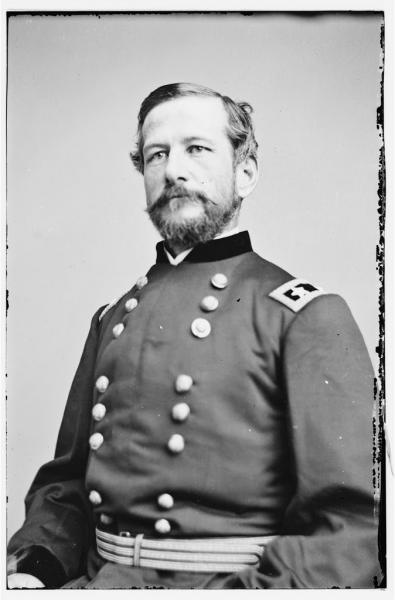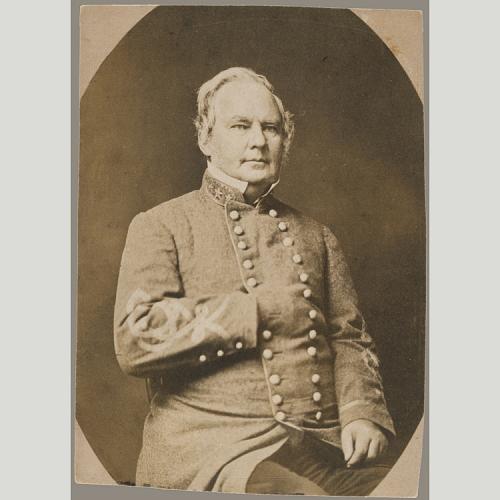By William D. Hickox, University of Kansas
Biographical information:
- Date of birth: July 7, 1824
- Place of birth: Washington, D.C.
- Claim to fame: Brevet Major General in the Union Army; led cavalry at the Battle of Brandy Station; defeated Sterling Price at the Battles of Byram’s Ford, Westport, and Mine Creek.
- Nickname: “The Knight of Romance”
- Date of death: February 17, 1897
- Place of death: Washington, D.C.
- Cause of death: Died in his sleep
- Final resting place: Congressional Cemetery, Washington, D.C.
Alfred Pleasonton was a Union cavalry general during the Civil War. While he is best known for leading the Army of the Potomac’s Cavalry Corps in the Gettysburg Campaign, Pleasonton also played a crucial role on the Western Border. After being transferred to the Department of the Missouri, Pleasonton helped to defeat Sterling Price’s epic cavalry raid in October 1864. Pleasonton had some skill as a commander, but his constant scheming and self-promotion earned him many enemies.
Pleasonton was born to a well-connected family in Washington, D.C., on July 7, 1824. After graduating from the U.S. Military Academy at West Point, he distinguished himself as a dragoon officer in the Mexican War. Pleasonton was a captain when the Civil War began in April 1861. In little more than a year, he advanced to brigadier general of volunteers and went on to lead a cavalry division in several campaigns in Virginia and Maryland. After the Battle of Chancellorsville in May 1863, Pleasonton falsely claimed that he had saved the Army of the Potomac from destruction. Still, his boasting gained him a promotion to major general and command of the Cavalry Corps.
Despite the misspellings, the cities of Pleasanton, California, and Pleasanton, Kansas, are both named after Alfred Pleasonton.Pleasonton was a strict disciplinarian and an able administrator; it had been his suggestion that the cavalry become more efficient by adopting a corps structure. Yet he was a lackluster field commander who angered many of his subordinates by taking credit for their battlefield successes. “You always see his name in the papers,” one of Pleasonton’s officers noted, “but to us who have served under him and seen him under fire he is notorious as a bully and toady. He does nothing save with a view to a newspaper paragraph.” Although Pleasonton’s cavalry contributed to the Union victory in the Gettysburg Campaign, he had earned the enmity of his superiors and lost command of the Cavalry Corps in early 1864.
Pleasonton found himself transferred to the Department of the Missouri, a common dumping-ground for unpopular officers. On April 11, he assumed duty as second-in-command of the Department and commanding officer of the District of Central Missouri. With no major combat occurring in the area, Pleasonton concentrated on staff work. The situation changed dramatically in mid-September, however, when Confederate Major General Sterling Price invaded Missouri with 12,000 men. Price hoped to weaken the Union’s hold on the state, recruit Missourians for the Confederacy, and undermine President Abraham Lincoln’s reelection campaign. The rebel commander moved on St. Louis, but Pleasonton and a Union cavalry force helped save the city from capture. Price’s Army of Missouri then changed course and headed west toward Jefferson City with Pleasonton in pursuit.
Pleasonton beat Price to Jefferson City and organized a defense. Deciding not to attack the city, Price resumed his westward course with a rapidly depleting command. Pleasonton, meanwhile, formed a division of 6,600 cavalrymen and gave chase. By October 22, the rival forces had reached the outskirts of Kansas City. With uncharacteristic energy and daring, Pleasonton attacked the enemy with his outnumbered division, waving a riding crop as he led the charge. After forcing a rebel brigade out of Independence, Pleasonton kept up the attack and vowed to “push them all night.” By the morning of October 23, the Union cavalry had driven one Confederate division back against another stationed south of Westport. With Union troops under Major General Samuel R. Curtis arriving from Kansas City, Price was outnumbered and facing attack from two directions.
Pleasonton’s division played an instrumental role in the ensuing Battle of Westport. While Curtis’s troops attacked Price’s main body from the north, Pleasonton struck the Confederate rearguard holding Byram’s Ford on the Big Blue River to the east. Pleasonton ordered his horsemen forward in charge after charge, at one point firing one of his brigade commanders after the brigade did not perform well. After three hours of combat, the Union troopers finally captured the west bank of the ford. Pleasonton then hit the right flank of the enemy divisions facing Curtis and cut the rebel army in two. Price and his surviving men fled south in disorder. In the largest battle fought west of the Mississippi River, the Union troops had won a significant victory.
October 23 was one of Pleasonton’s finest days of the war, but the old Pleasonton resurfaced afterward.October 23 was one of Pleasonton’s finest days of the war, but the old Pleasonton resurfaced afterward. In a post-battle meeting of the Union generals, Pleasonton maintained that his men and horses needed rest and asked Curtis to release him from the campaign. The annoyed Curtis persuaded Pleasonton to keep his division with the army as it tracked Price. Pleasonton caught up with the retreating rebels on October 25 as they crossed the Marais des Cygnes River in eastern Kansas. Price’s men were able to escape, but the Union cavalry overtook them later that day at Mine Creek. Pleasonton charged the much larger enemy force, broke their line, and routed them. Among the several hundred Confederates captured was General John S. Marmaduke, one of Price’s division commanders. The Federals attacked for the third and final time that day at the Marmiton River. Once again, Price and the bulk of his men avoided capture, fleeing back over the border into Missouri and heading toward Arkansas.
Price’s shattered force could have been destroyed had Pleasonton kept up the chase. That night, however, Pleasonton turned his division west and headed to Fort Scott for rest and resupply, telling Curtis that “further pursuit was needless.” Once again, the commanding general persuaded Pleasonton to rejoin the march. Pleasonton left the campaign for good on October 27. Explaining that “the effects of a severe fall and exhaustion” had rendered him paralyzed, he returned to St. Louis on medical leave. Pleasonton had performed valuable service in the Missouri campaign, but his lethargy after October 25 probably allowed Price and his survivors to escape.
Pleasonton was so notorious for his vanity and dishonesty that the press mocked him as “The Knight of Romance.”Pleasonton’s career after October 1864 was inglorious. He was never transferred back to the eastern theater and failed to regain the fame and advancement he had once enjoyed, finishing out the war as commander of the District of St. Louis. By this point, Pleasonton was so notorious for his vanity and dishonesty that the press mocked him as “The Knight of Romance.” Deeply resentful toward the army, Pleasonton resigned on January 1, 1868. Several civilian jobs failed to gain him financial security, and the general retired to a life of poverty, obscurity, and poor health in Washington, D.C. Alfred Pleasonton died on February 17, 1897, maintaining to the end that he deserved more recognition for his services.
Suggested Reading:
Longacre, Edward G. "Alfred Pleasonton: 'The Knight of Romance.'" Civil War Times Illustrated. Vol. 13, no. 8 (December 1974): 12-23.
Monnett, Howard N. Action Before Westport 1864. Boulder, Colorado: University Press of Colorado, 1995, revised edition. Originally published in 1964.
Petruzzi, J. David. "The Fleeting Fame of Alfred Pleasonton." America's Civil War. Vol. 18, no. 1 (March 2005): 22-28.
Starr, Stephen Z. The Union Cavalry in the Civil War. 3 vols. Baton Rouge: Louisiana State University Press, 1979-1985.
Styple, William B. Generals in Bronze: Interviewing the Commanders of the Civil War. Kearny, NJ: Belle Grove Publishing Co., 2005.
Wittenberg, Eric J. The Union Cavalry Comes of Age: Hartwood Church to Brandy Station. Dulles, VA: Brassey's, 2003.
Cite This Page:
Hickox, William. "Pleasonton, Alfred" Civil War on the Western Border: The Missouri-Kansas Conflict, 1854-1865. The Kansas City Public Library. Accessed Thursday, April 18, 2024 - 21:20 at https://civilwaronthewesternborder.org/encyclopedia/pleasonton-alfred



